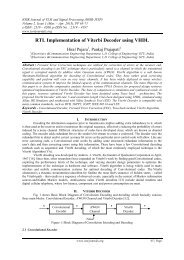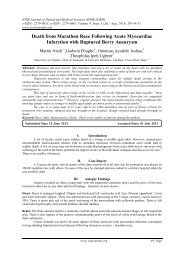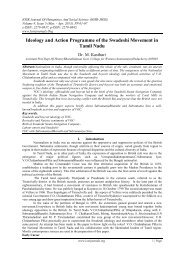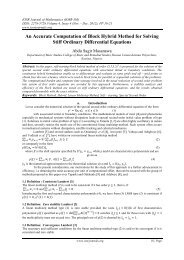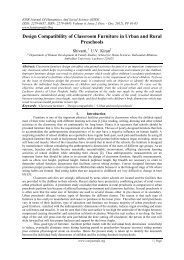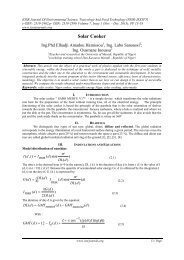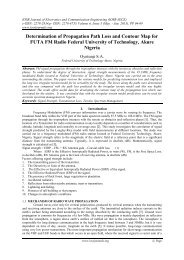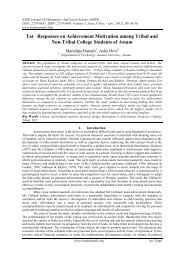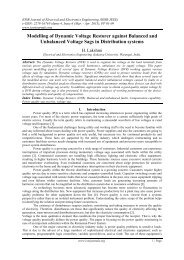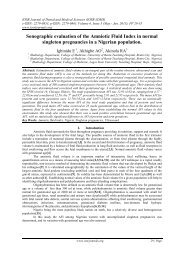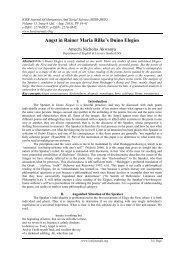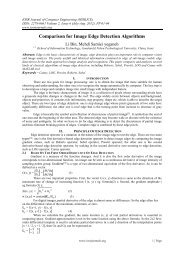Initial Conquest of India by Turks and Their Slaves - IOSR
Initial Conquest of India by Turks and Their Slaves - IOSR
Initial Conquest of India by Turks and Their Slaves - IOSR
Create successful ePaper yourself
Turn your PDF publications into a flip-book with our unique Google optimized e-Paper software.
<strong>Initial</strong> <strong>Conquest</strong> Of <strong>India</strong> By <strong>Turks</strong> And <strong>Their</strong> <strong>Slaves</strong><br />
Bosworth; Later Ghaznavids,splender <strong>and</strong> decay:the dynasty in Afghanistan <strong>and</strong> Northern <strong>India</strong> 1040-<br />
1186(Edinburgh,1977),111-22[Hereafter Bosworth,Later Gaznavids] ,p.61-68; Tarikh-i-Farishta<br />
(Lucknow,1864),p.48-49;C.J.Tornberg,X,p.72-74.<br />
A. Maricq <strong>and</strong> G. Weit; Le minaret de Djam. La decouverte de la capitale des sultans Ghorides (XII-XIII<br />
siecles) (paris, 1959),p 31-44, contain a historical survey <strong>of</strong> the dynasty down to C. 1200;Cf Jackson Peter;The<br />
Delhi Sultanate,A Political <strong>and</strong> Military History,Cambridge University Press,1999,more generally, see C.E.<br />
Bosworth,The Early Islamic History <strong>of</strong> Ghur,Central Asiatic Journal,6 (1961); Ch.Pellat et al.(eds.),The<br />
encyclopaedia <strong>of</strong> Islam,new edition (Leiden,1954); A.D.H. Bivar, ‘Ghur’ ibid. For what follows, see also<br />
Bosworth; Later Ghaznavids,p.111-22; idem, ‘The political <strong>and</strong> dynastic history <strong>of</strong> the Iranian world (A.D.<br />
1000-1217)‟, in J.A. Boyle (ed). The Cambridge history <strong>of</strong> Iran, V. The Saljuq <strong>and</strong> Mongol periods (Cambridge,<br />
1968), 157-66, 185-92.<br />
.J.Tornberg, XI, p. 168.; Juwaini Alauddin Ata Malik;Tarikh-i-Jahan Gusha-e-Juwaini,ed. Abdul Wahab<br />
Qazwini.2 vols.,London,Gibb memorial series,1912-1916.Vol.III a facsimile edition,<strong>by</strong><br />
E.D.Ross,London,1931.Eng trans.J.A.Boyle,2 vols,Manchester,1958, places the event in 565/1169.[Hereafter<br />
Juwaini], Cf.A.B.M. Habibullah, Foundation <strong>of</strong> Muslim rule in <strong>India</strong>, Allahabad, 1961; p. 105.[Hereafter<br />
Habibullah Foundation].<br />
Juwaini. II, p. 10 for these periodical conflicts in which the help <strong>of</strong> Qarakhitai <strong>and</strong> the Seljug or the Khwarizm<br />
Shah was invariably sought <strong>by</strong> the two contending parties, see Bartold;Turkistan down to the Mongol<br />
Invasion,Eng. Trans. By H.A.R. Gibb,London,1928,2 nd ed.1958 op.cit, p. 333ff.[Hereafter Bartold]<br />
C.J.Tornberg, Xi. P. 168; Juwaini, idem, places the event in 565/1169, but Bartold upholds the above date.<br />
Hamdullah Mustaufi Qazwini; Tarikh-i-Guzidah,Fascimile ed.,Gibb Memorial series, London, 1913,p.<br />
460,[Hereafter, Guzidah];Al-Raw<strong>and</strong>i Abu Bakr Muhammad. b.Ali;Rahatus-Sudur<br />
ed,M.Iqbal,Cambridge,1922, p. 175.[Hereafter, Raw<strong>and</strong>i]<br />
Minhaj,Abu Umar b. Siraj Juzjani;Tabaqat-i-Nasiri,(a) ed.Nasau Lees,Khadim Hussain,<strong>and</strong> Abdul Hai<br />
Bib.Ind.Calcutta,1864.(b)English trans.By H.G.Raverty,2 Vols,Bib.Ind Calcutta,1897, p. 55<br />
ff.[Hereafter,Minhaj] It is not certain who was the antagonist <strong>of</strong> Alauddin at Ghazni for the accounts are not<br />
unanimous as to the date <strong>of</strong> Bahrams death <strong>and</strong> the accession <strong>of</strong> his son, Khursau.Minhaj, p. 24-5, states that<br />
Bahram was driven out <strong>of</strong> Ghazni <strong>by</strong> Alauddin, <strong>and</strong> places his death in 552/1156. An anecdote on p. 115,<br />
however implies that it was khusrau who apposed Alauddin, Guzidah, I, p. 406, <strong>and</strong> C.J.Tornberg, xi, p. 85, date<br />
Bahram‟s death in 544/1149 <strong>and</strong> 548/1153, respectively.Baizawi,Abu Said Abdullah;Nizamat-<br />
Twarikh.Bm.Add.16708.f.51a, states Bahram died before Alauddin‟s march on Ghazni, which must have<br />
occurred soon after 544, the year in which Saifuddin‟s head was sent to Sanjar.Cf Habibullah Foundation.<br />
C.J.Tornberg, xi, p. 74. places Alauddin‟s sack <strong>of</strong> Ghazni after his defeat <strong>by</strong> Sanjar in 547, which seems<br />
improbable. He further state that Alauddin placed his brother Saifuddin on the throne <strong>of</strong> Ghazni <strong>and</strong> on bahram<br />
Subsequently murdering the latter, once again marched to sack the city. But Bahram died in the meantime <strong>and</strong><br />
his successor Khusrau had fled to Punjab. Guzidah supports this but confuses Khusrau with his son Khursrau<br />
Malik, last <strong>of</strong> the Ghaznawids. According to Minhaj, Khursrau left Ghazni only on the approach <strong>of</strong> the Ghuzz<br />
who then occupied it for 10 years. The dates 552/1157 <strong>and</strong> 555/1160 for the accessions <strong>of</strong> Khusrau <strong>and</strong> his son,<br />
Khusrau Malik, quoted <strong>by</strong> Raverty: op. cit, p. 114, note from their suppositious coins described in a manuscript<br />
entitled Tafsil-i-Sikkah, do not prove anything, since the legends given their in are fictitious <strong>and</strong> the works was<br />
admittedly compiled late in the 18 Century.<br />
A.M. Husain (ed).; Futuh-us-Salatin <strong>of</strong> Isami (Agra, 1938).<br />
Fakhre Mudabbir(Muhammad b. Mansur b. Said Qurashi);Shajarat (or Bahr) al-Ansab, partial edn. <strong>by</strong> Sir E.<br />
Denison Ross;Tarikh [sic]-i-Fakhr al-Din Mubarakshah (London,1927), 19-20. Habibullah, Foundation, 36-7.<br />
S.H. Hodivala, Studies in Indo-Muslim history (Bombay, 1939-57, 2 vols), I, 141, for Daybul, See S.<br />
Qudratullah Fatimi; „The Twin Ports <strong>of</strong> Daybul’, in Hamida Khuhro (ed.), Sind through the centuries (Oxford<br />
<strong>and</strong> Karachi, 1981), 97-105; Al-Hind, I,p. 181-3.<br />
For this term see. B.D. Chattopadhayaya; „Origin <strong>of</strong> the Rajputs: the political, economic <strong>and</strong> social processes in<br />
early medieval Rajasthan’, IHR 3 (1976), 59-82, repr.in his The Making <strong>of</strong> early medieval <strong>India</strong> (Oxford <strong>and</strong><br />
Delhi, 1994), 57-88.<br />
For an account <strong>of</strong> the dynasty achievements see Majumdar; The Gurjara – Pratihara Empire.<br />
On one or two occasions when Muizzuddin came to Peshawar he might have used the Khaiber, but the<br />
southern routes were more convenient. The troops <strong>of</strong> the Khwarizan Shah, with a view to capture Yalduz, the<br />
rulers <strong>of</strong> Ghazni, in 1215, are stated to have seized the frontier routes into Hindusthan, “Leading towards Gardiz<br />
<strong>and</strong> Karaha pass”, that is the Kurram valley; Yalduz had to take a more southeasterly route, through the „Sang-i-<br />
Surkh‟ mountains, which according to the Reverty, op. cit. p. 505, is the name given to three or four passes;<br />
Minhaj p. 135. Through the province <strong>of</strong> „Karman <strong>and</strong> Sankuran,‟ the old name <strong>of</strong> the tract between the Salt<br />
Range <strong>and</strong> Gardiz south <strong>of</strong> the „Safed Koh‟, passed the lower route into Hindustan usually used <strong>by</strong> Muizz-uddin;<br />
Minhaj, p. 132; Raverty. Op. cit pp. 498-9; see also Raverty,H.G; Notes on Afghanistan,London,1880. pp.<br />
www.iosrjournals.org<br />
9 | Page



